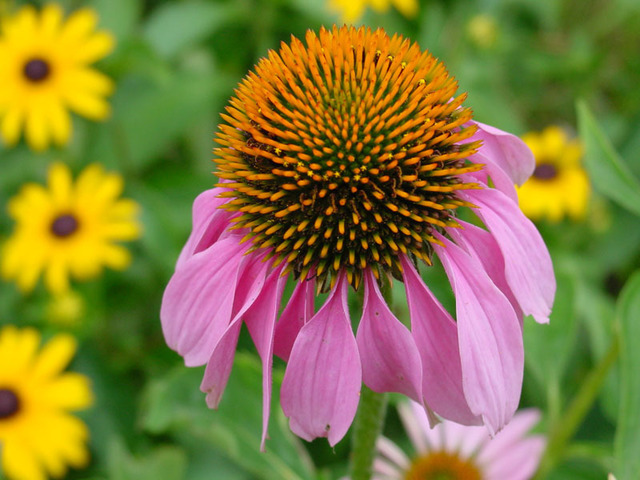

Companion plants for Purple Coneflower include Mealy Blue Sage ( Salvia farinacea), Black-eyed Susan ( Rudbeckia hirta), and Little Bluestem ( Schizachyrium scoparium). Various parts of Purple Coneflower are used as herbal medicine, but please don’t count on NICE for medical advice! Consider using instead of exotic Gerbera Daisy ( Gerbera jamesonii) or African Daisies (Osteospermum) species. The cut flowers are long-lasting in bouquets. Purple Coneflower attracts butterflies as well as native bees and its seed in the dried flowerheads feeds fall and winter birds. In addition, it may be propagated by cuttings and will self-seed, if the spent flowers are not removed. This is important for propagating the cultivars, because they will not breed true from seed. The plants will grow in size each year and may be divided every 4-5 years by digging up the clump, lifting it out of the ground, and breaking it apart by hand. Purple Coneflower is great in border, meadow, prairie, cutting, and native plant gardens, as well as woodland gardens in part-sun. Similarly, it needs good drainage, like many other native Texas plants.
#Purple coneflower colors full
Watering Instructions:ĭuring long dry spells, Purple Coneflower may appreciate supplemental water if planted in full sun. Purple Coneflower thrives in part shade to sun and a range of soil types.

Furthermore, numerous cultivars are now available in nurseries, in different heights, with petal colors ranging from white to deep orange to deep red, and with different colored flower cones. The cone may be flattened and is prickly. Each flower has 10-20 pink to lavender ray florets surrounding a central yellowish- to reddish-brown cone of numerous disk florets. The showy flowers span 2.5-5 inches across. Its daisy-like flowers are held high on top of its stems. Purple Coneflower blooms in late May and intermittently through the end of summer in North Texas. Coneflower describes the flower’s center shape. Echinacea comes from the Greek echinos, meaning spiny or prickly, while purpurea refers to the petal color of wild Purple Coneflower. Purple Coneflower’s common and genus names reflect its flower characteristics. Most importantly, it is drought, heat, and poor soil tolerant. Its dark green, hairy-rough, alternate or opposite leaves are up to 6” long and 3” wide, and are smaller at the top of the stems. It grows about 1-2 feet wide and 2-4 feet tall in bloom. Maybe once that's all done you will have a different opinion on things.Purple Coneflower is an herbaceous perennial in the sunflower family. I still have to paint my basement around, get my shutters put up, bottom of the deck finished etc. My husband works 12 hr shifts and he's been the one doing things, so there for its not all done out side.

I knew what I wanted to do ( kind of) as for my door color but the rest I was a little lost on. I listened and done most of what people said. As for not understanding why people don't "listen" to what other recommendations, if you don't like a color will you paint something that color? No! It's ideas that you are asking people for and they share, it's up to you to decide if you will do it or not. And like I've stated before I have small children so light colours don't always work. As for the porch colours, and the stains, we done black and grey vs black and white to see how it was going to look. We decided on the small flower beds due to the fact that we are painting our siding or replacing it this fall to a grey. G L I have a very tiny bit of space on the front of my house, that my kids use ( 5, 7 & 8 yrs old) so I done grass vs having flowers take it all over.


 0 kommentar(er)
0 kommentar(er)
